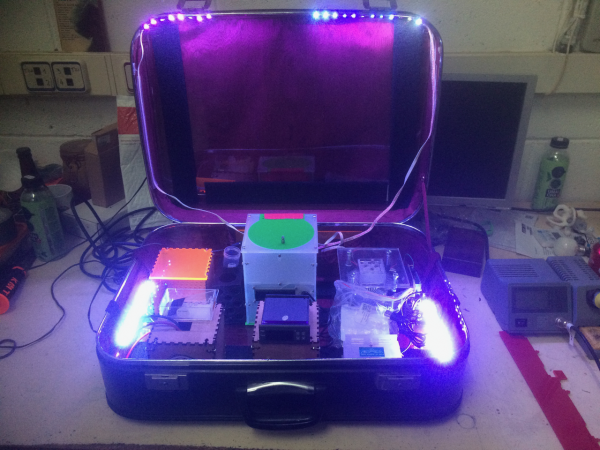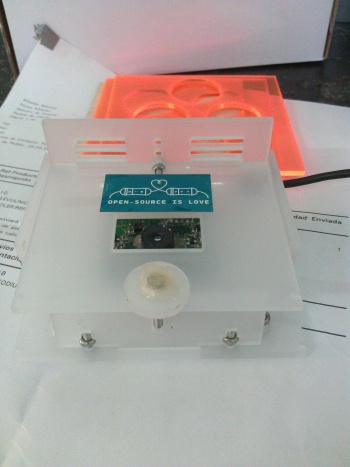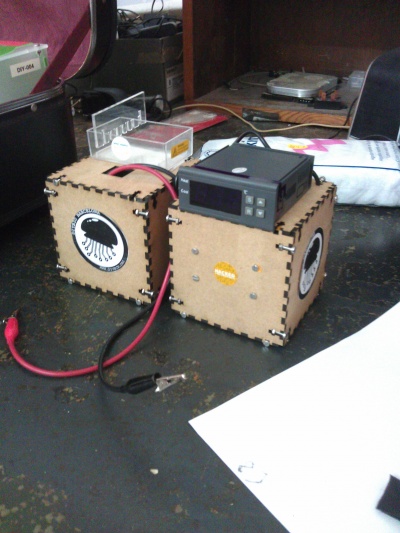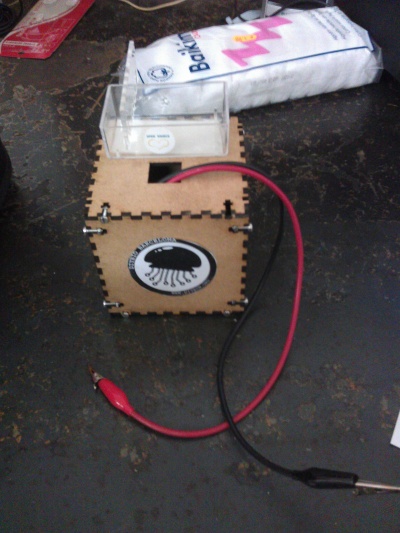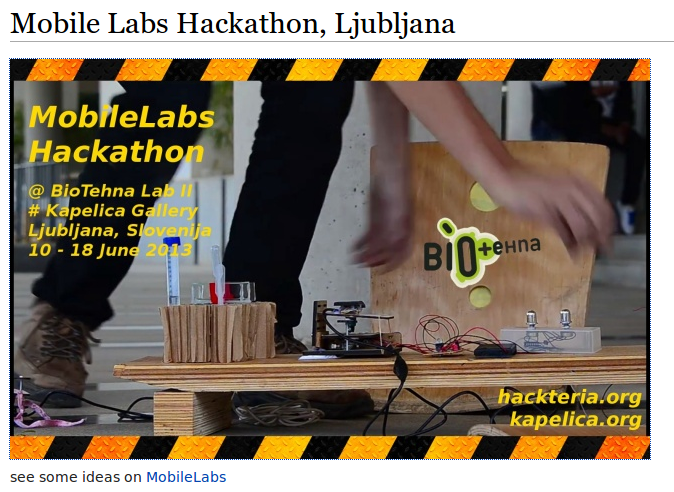Diferencia entre revisiones de «DiyBIObcn»
| (No se muestran 15 ediciones intermedias del mismo usuario) | |||
| Línea 6: | Línea 6: | ||
== Lab-on-a-Case Circuit == | == Lab-on-a-Case Circuit == | ||
| + | |||
| + | [[Archivo:Maleta3.png|400px]] [[Archivo:Maleta2.png|600px]] | ||
| + | |||
We are biology. Life is fragile and we need to foster its continuity. In order to protect life, it is necessary to detect, track and identify different biological players: antibodies, genes, biomarkers, viruses, bacteria, pathogen microorganisms, etc. They can be located in the food we eat, in the environment we live in, or in contact with us. This area of biology is called microbiology. | We are biology. Life is fragile and we need to foster its continuity. In order to protect life, it is necessary to detect, track and identify different biological players: antibodies, genes, biomarkers, viruses, bacteria, pathogen microorganisms, etc. They can be located in the food we eat, in the environment we live in, or in contact with us. This area of biology is called microbiology. | ||
| Línea 17: | Línea 20: | ||
'''Webcam-Microscope:''' | '''Webcam-Microscope:''' | ||
| + | |||
| + | [[Archivo:Micro.jpg|350px]] | ||
You can make a microscope out of a webcam. The basic idea is that, lenses in a webcam are normally designed to cover a large area and focus it into a small CCD sensor. By turning the lens, it creates a larger image of the small focused area. So, it can do the work of a microscope. It is only necessary to add a light source and to keep the sample well positioned and in the focal area. To do so, a case is designed and built with 3D laser-cut pieces and a white LED source is added. Some designs have been proposed by hackteria and you can directly find them in their webpage. | You can make a microscope out of a webcam. The basic idea is that, lenses in a webcam are normally designed to cover a large area and focus it into a small CCD sensor. By turning the lens, it creates a larger image of the small focused area. So, it can do the work of a microscope. It is only necessary to add a light source and to keep the sample well positioned and in the focal area. To do so, a case is designed and built with 3D laser-cut pieces and a white LED source is added. Some designs have been proposed by hackteria and you can directly find them in their webpage. | ||
| Línea 36: | Línea 41: | ||
Cells and bacteria require stable temperature conditions in order to grow. To do so, many designs have been built. They require a sensor, a heating element to act as a source and a way to spread the heat. A peltier can be used as heating source so it can work as a heat source or as a cold source. A small fan is normally used to spread the heat, and isolation is also required. The control unit can be implemented in an Arduino, or as an alternative, there are cheap temperature controls on the Web ([https://es.aliexpress.com/item/10A-12V-Digital-Temperature-Controller-Thermocouple-4-to-120-degree-centigrade-with-Sensor/32525893859.html?spm=a2g0s.13010208.99999999.269.vuAn5E like this one]) which include the temperature sensor. A heat resistance or a light bulb can be used as a heat source. The used fan was ([https://www.amazon.es/gp/product/B00HKF1LTW/ref=oh_aui_detailpage_o09_s00?ie=UTF8&psc=1 here one]) | Cells and bacteria require stable temperature conditions in order to grow. To do so, many designs have been built. They require a sensor, a heating element to act as a source and a way to spread the heat. A peltier can be used as heating source so it can work as a heat source or as a cold source. A small fan is normally used to spread the heat, and isolation is also required. The control unit can be implemented in an Arduino, or as an alternative, there are cheap temperature controls on the Web ([https://es.aliexpress.com/item/10A-12V-Digital-Temperature-Controller-Thermocouple-4-to-120-degree-centigrade-with-Sensor/32525893859.html?spm=a2g0s.13010208.99999999.269.vuAn5E like this one]) which include the temperature sensor. A heat resistance or a light bulb can be used as a heat source. The used fan was ([https://www.amazon.es/gp/product/B00HKF1LTW/ref=oh_aui_detailpage_o09_s00?ie=UTF8&psc=1 here one]) | ||
A 10x10 cm box was designed in http://www.makercase.com/ and laser-cut in MDF (link to schematics here). | A 10x10 cm box was designed in http://www.makercase.com/ and laser-cut in MDF (link to schematics here). | ||
| + | |||
| + | [[Archivo:incu.jpg|400px]] | ||
If it’s even necessary to control the humidity, there are humidity controls in the market ready to be employed. ([https://es.aliexpress.com/item/220V-Digital-Air-Humidity-Control-Controller-Range-1-99-MH13001-Free-Shipping/32222575291.html?spm=a2g0s.13010208.99999999.262.vuAn5E this one]) | If it’s even necessary to control the humidity, there are humidity controls in the market ready to be employed. ([https://es.aliexpress.com/item/220V-Digital-Air-Humidity-Control-Controller-Range-1-99-MH13001-Free-Shipping/32222575291.html?spm=a2g0s.13010208.99999999.262.vuAn5E this one]) | ||
| Línea 65: | Línea 72: | ||
=== 5. Check if your genes of interest are there === | === 5. Check if your genes of interest are there === | ||
| + | |||
| + | [[Archivo:electroph.jpg|400px]] | ||
'''Electrophoresis System''': | '''Electrophoresis System''': | ||
| Línea 86: | Línea 95: | ||
In early science, the home was often where the laboratory art was pursued, in close juxtaposition to other aspects of ordinary domestic life. William Thomson himself hints at this in suggesting that Archimedes used his bathroom to study the laws of hydrostatics. Similarly, the kitchen that, since the Renaissance, has been most closely linked with the laboratory. As Bruno Latour reminds us, a few years later, in 1865, Claude Bernard presented work in a physiological laboratory as being akin to passage through a “long and ghastly kitchen.” (Goodey, 2008). Far from being self-evidently a place “set apart” for artificial experimenting on the natural world (a narrowly twentieth-century vision of the laboratory), it could be part of the natural world and indeed, nonmetaphorically, the very means for productively elaborating organic life (Kohler, 2002). | In early science, the home was often where the laboratory art was pursued, in close juxtaposition to other aspects of ordinary domestic life. William Thomson himself hints at this in suggesting that Archimedes used his bathroom to study the laws of hydrostatics. Similarly, the kitchen that, since the Renaissance, has been most closely linked with the laboratory. As Bruno Latour reminds us, a few years later, in 1865, Claude Bernard presented work in a physiological laboratory as being akin to passage through a “long and ghastly kitchen.” (Goodey, 2008). Far from being self-evidently a place “set apart” for artificial experimenting on the natural world (a narrowly twentieth-century vision of the laboratory), it could be part of the natural world and indeed, nonmetaphorically, the very means for productively elaborating organic life (Kohler, 2002). | ||
| + | In line with this, here are some example that inspire us and which we find can/should inspire you! | ||
| − | + | ==== Mobile Labs Hackteria ==== | |
| + | [https://hackteria.org/wiki/MobileLabs Hackteria MobileLabs 2013] | ||
| − | + | [https://www.slideshare.net/dusjagr/making-labs-hackteria-ycam-2017 Dusjagr on making labs] | |
| + | [[Archivo:Mobilelabs.png]] | ||
| − | + | ==== Digital Naturalism ==== | |
| − | + | http://andy.dorkfort.com/andy/digitalnatural/ | |
| − | + | http://kit-of-no-parts.at/ | |
| − | + | http://www.plusea.at/?category_name=a-wearable-studio-practice | |
| + | |||
| + | https://www.youtube.com/watch?v=FH56ABYqEmE | ||
| + | |||
| + | https://news.mongabay.com/wildtech/2017/05/rugged-innovation-meeting-the-challenges-of-bringing-high-tech-dna-analysis-to-the-field/ | ||
| + | |||
| + | https://wildtech.mongabay.com/2015/05/scientists-identify-frog-through-dna-without-leaving-forest/ | ||
| + | |||
| + | ==== BentoLab ==== | ||
| + | |||
| + | https://www.bento.bio/ | ||
| + | |||
| + | ==== Hackbases ==== | ||
| + | |||
| + | https://wiki.hackerspaces.org/Cyberhippietotalism | ||
| + | |||
| + | https://totalism.org/alike | ||
==References== | ==References== | ||
| − | 1. S. Kanchi, M. I. Sabela, P. S. Mdluli, Inamuddin, and K. Bisetty, "Smartphone based bioanalytical and diagnosis applications: A review," Biosens. Bioelectron. 102, 136–149 (2018). | + | 1. S. Kanchi, M. I. Sabela, P. S. Mdluli, Inamuddin, and K. Bisetty, "Smartphone based bioanalytical and diagnosis applications: A review," Biosens. Bioelectron. 102, 136–149 (2018). |
| + | |||
2. T. F. Wu, Y. C. Chen, W. C. Wang, A. S. Kucknoor, C. J. Lin, Y. H. Lo, C. W. Yao, and I. Lian, "Rapid waterborne pathogen detection with mobile electronics," Sensors (Switzerland) 17, 1–11 (2017). | 2. T. F. Wu, Y. C. Chen, W. C. Wang, A. S. Kucknoor, C. J. Lin, Y. H. Lo, C. W. Yao, and I. Lian, "Rapid waterborne pathogen detection with mobile electronics," Sensors (Switzerland) 17, 1–11 (2017). | ||
| + | |||
3. K. D. Long, E. V. Woodburn, H. M. Le, U. K. Shah, S. S. Lumetta, and B. T. Cunningham, "Multimode smartphone biosensing: the transmission, reflection, and intensity spectral (TRI)-analyzer," Lab Chip (2017). | 3. K. D. Long, E. V. Woodburn, H. M. Le, U. K. Shah, S. S. Lumetta, and B. T. Cunningham, "Multimode smartphone biosensing: the transmission, reflection, and intensity spectral (TRI)-analyzer," Lab Chip (2017). | ||
| + | |||
4. O. Mudanyali, S. Dimitrov, U. Sikora, S. Padmanabhan, I. Navruz, and A. Ozcan, "Integrated rapid-diagnostic-test reader platform on a cellphone.," Lab Chip 12, 2678–86 (2012). | 4. O. Mudanyali, S. Dimitrov, U. Sikora, S. Padmanabhan, I. Navruz, and A. Ozcan, "Integrated rapid-diagnostic-test reader platform on a cellphone.," Lab Chip 12, 2678–86 (2012). | ||
| + | |||
5. T. Laksanasopin, T. W. Guo, S. Nayak, A. A. Sridhara, S. Xie, O. O. Olowookere, P. Cadinu, F. Meng, N. H. Chee, J. Kim, C. D. Chin, E. Munyazesa, P. Mugwaneza, A. J. Rai, V. Mugisha, A. R. Castro, D. Steinmiller, V. Linder, J. E. Justman, S. Nsanzimana, and S. K. Sia, "A smartphone dongle for diagnosis of infectious diseases at the point of care," 7, (2015). | 5. T. Laksanasopin, T. W. Guo, S. Nayak, A. A. Sridhara, S. Xie, O. O. Olowookere, P. Cadinu, F. Meng, N. H. Chee, J. Kim, C. D. Chin, E. Munyazesa, P. Mugwaneza, A. J. Rai, V. Mugisha, A. R. Castro, D. Steinmiller, V. Linder, J. E. Justman, S. Nsanzimana, and S. K. Sia, "A smartphone dongle for diagnosis of infectious diseases at the point of care," 7, (2015). | ||
| + | |||
6. A. Ganguli, A. Ornob, H. Yu, G. L. Damhorst, W. Chen, F. Sun, A. Bhuiya, B. T. Cunningham, and R. Bashir, "Hands-free smartphone-based diagnostics for simultaneous detection of Zika, Chikungunya, and Dengue at point-of-care," Biomed. Microdevices 19, 1–13 (2017). | 6. A. Ganguli, A. Ornob, H. Yu, G. L. Damhorst, W. Chen, F. Sun, A. Bhuiya, B. T. Cunningham, and R. Bashir, "Hands-free smartphone-based diagnostics for simultaneous detection of Zika, Chikungunya, and Dengue at point-of-care," Biomed. Microdevices 19, 1–13 (2017). | ||
| + | |||
7. A. M. Caliendo, D. N. Gilbert, C. C. Ginocchio, K. E. Hanson, L. May, T. C. Quinn, F. C. Tenover, D. Alland, A. J. Blaschke, R. A. Bonomo, K. C. Carroll, M. J. Ferraro, L. R. Hirschhorn, W. P. Joseph, T. Karchmer, A. T. MacIntyre, L. B. Reller, and A. F. Jackson, "Better Tests, Better Care: Improved Diagnostics for Infectious Diseases," Clin. Infect. Dis. 57, S139–S170 (2013). | 7. A. M. Caliendo, D. N. Gilbert, C. C. Ginocchio, K. E. Hanson, L. May, T. C. Quinn, F. C. Tenover, D. Alland, A. J. Blaschke, R. A. Bonomo, K. C. Carroll, M. J. Ferraro, L. R. Hirschhorn, W. P. Joseph, T. Karchmer, A. T. MacIntyre, L. B. Reller, and A. F. Jackson, "Better Tests, Better Care: Improved Diagnostics for Infectious Diseases," Clin. Infect. Dis. 57, S139–S170 (2013). | ||
Revisión actual del 19:45 26 nov 2017
DIYBio Barcelona was born after a brief meeting at Fab12. Our activity started at Made Makerspace on 2012, until we moved to Hangar on March 2016.
Our space is open to public on Thursday afternoon. We are open to collaborations. Tell us about your project!
Conexion directa con Nuria Conde
Lab-on-a-Case Circuit
We are biology. Life is fragile and we need to foster its continuity. In order to protect life, it is necessary to detect, track and identify different biological players: antibodies, genes, biomarkers, viruses, bacteria, pathogen microorganisms, etc. They can be located in the food we eat, in the environment we live in, or in contact with us. This area of biology is called microbiology.
There is a need of biological detection in remote areas where there is a lack of access to laboratory equipment or clinical setups. Moreover, the detection must be performed in areas without electricity or internet access, in remote regions in the jungle, desert or forest. Kanchi et al have recently published a review of different detection methods based in cell phones or smart phones in Africa [1]. Mobile electronics are also being used for detection of pathogens in water [2], for spectrometry [3], for lateral flow immunoassays [4], for HIV detection [5], etc. More recently, a micro-lab- on-a- chip has been developed for Zika, Chikungunya and Dengue detection in yet-expensive clinical facilities with bulky and costly equipment [6]. In that sense, Caliendo et al recommend stimulating the research and development in diagnostic techniques [7], which we think should include all different research actors: institutional research centers (academic and industrial research) and community open labs (citizen science). Each of these ecosystems will produce different outputs and will tackle different problems in both hemispheres of the world.
We want to introduce our open source approach which could be used for detection of different maladies, for example, HPV detection by Polymerase Chain Reaction PCR. The kit includes a first section for samples incubation and preparation, then a PCR unit for tagging and amplification, and finally a detection part for direct readout. The whole kit could operate with a conventional car battery which in turn could be charged by other energy sources (mechanical, wind, solar, hydraulic, etc.). The whole case was redesigned to place all these machines stacked and placed appropriately while moving. One sample of the uses of the lab-on- a-case could include:
1. Extract the sample and see it in the…
Webcam-Microscope:
You can make a microscope out of a webcam. The basic idea is that, lenses in a webcam are normally designed to cover a large area and focus it into a small CCD sensor. By turning the lens, it creates a larger image of the small focused area. So, it can do the work of a microscope. It is only necessary to add a light source and to keep the sample well positioned and in the focal area. To do so, a case is designed and built with 3D laser-cut pieces and a white LED source is added. Some designs have been proposed by hackteria and you can directly find them in their webpage.
More resources: Waag Society Biohack Academy Class 2; Classic Hackteria Styyyle!;
Endoscope:
There are cheap endoscopes already in the market. This provides a way to explore areas of the body for self-exploration or self-diagnostic. It is worth to mention that it is always advised to consult with your personal medical doctor before taking any important decision.
[[1]]
2. Inoculate your petri dish and store it in the incubator.
Mini-incubator:
Cells and bacteria require stable temperature conditions in order to grow. To do so, many designs have been built. They require a sensor, a heating element to act as a source and a way to spread the heat. A peltier can be used as heating source so it can work as a heat source or as a cold source. A small fan is normally used to spread the heat, and isolation is also required. The control unit can be implemented in an Arduino, or as an alternative, there are cheap temperature controls on the Web (like this one) which include the temperature sensor. A heat resistance or a light bulb can be used as a heat source. The used fan was (here one) A 10x10 cm box was designed in http://www.makercase.com/ and laser-cut in MDF (link to schematics here).
If it’s even necessary to control the humidity, there are humidity controls in the market ready to be employed. (this one)
Larger incubators can be found in: BioDesign incu; Hackteria DIY Incu; Pelling Lab CO2 Incu;
3. Separate your samples.
Centrifuge:
Using the centipede force samples are separated. It is necessary to control the rotating speed. To do so, a control system has been implemented in an Arduino. The rotation speed is read from magnetic sensors, and a closed-loop control calibrates the driving current of the motor, thus, the speed. The head of the motor has been 3D-printed with the right shape and angle to place the standard Eppendorf tubes for sampling preparation. The whole supply of materials and designs are found in the next links:
HDD drive Centrifuge; Biohack Academy Centrifuge;
4. Copy your DNA.
Thermocycler:
Once the samples have been extracted, a thermocycler is necessary to perform a Polymerase Chain Reaction (PCR). In a PCR, DNA strains are de-naturalized and naturalized over and over, adding a polymerase that will create copies of the single strains sections where it attaches. Thus, a doubling of population will occur at each cycle, amplifying the number of strains with the genes where the polymerase attaches, thus, amplifying the desired genes of interest. To do so, a precise and quick control of temperature should be implemented. Changes in temperature from ~27 C to ~90 C degrees should be implemented. There are many designs already on the network, but all of them consist in a central unit controlling the heat source element, the fans for heat spreading, and a temperature sensor. One of the main challenges is the appropriate fabrication of the aluminum block where the Eppendorf tube sample lays. It should replicate the shape of the tip of the Eppendorf tube to ensure a proper heat exchange.
Many open designs can be found at: Wild OpenPCR; The Ninja PCR; MiniPCR;
5. Check if your genes of interest are there
Electrophoresis System:
To separate the different parts of the cut DNA, it is necessary to use a force to move them. In this case, due to the polar nature of the DNA, an electric field could do the job. So, an electric field is created between two electrodes, where the gel with DNA samples relies. The DNA will move across the gel and the larger strains will get stuck in the first part of the gel, the shorter ones will go further. To do so, electrodes are made of carbon sheets bought from www.carolina.com supplies. The tested power source was bought in amazon, 80 V, DC power booster (here) and the plastic cases bought in a local store where they sell cards. The combs were laser-cut and the gel made in-house.
Transilluminator:
In order to see if the genes you are looking for are there or not, you can use a tag. A molecular tag is a molecule that attaches to the genes of interest, but besides that, it has the capability to receive light from a given wavelength (normally blue, a higher energy wavelength) and radiate it in a different one (normally red, lower energy wavelength). So, a light source with blue leds is required, a holder to place the sample, and an optical filter to show only the red wavelengths. Open designs are already found in internet here. Our design was a 10 cm x 10 cm box laser-cut from www.makercase.com and the cap was modified to place an acrylic laser-cut optical filter. The LED matrix source can be a cheap lamp with batteries and the appropriate blue LEDs.
The whole case was redesigned to place all these machines stacked and placed appropriately while moving. The design of the machines includes the possibility of using batteries whenever possible. A car battery could provide all the required power to operate the whole lab-on-a-case.
Advanced boxology y Mobile Kits
Re-ocurring biohacking architectures
Along the years, biohackers alike have been working on exploring / building / opening / "making" (you name it) laboratories in all kinds of unorthodox contexts. Much of this work has emerged as a challenge to the fixed meaning of the term "laboratory" in the modern history of science, as opposed to its more flexible meaning throughout the earlier history of science and technology.
In early science, the home was often where the laboratory art was pursued, in close juxtaposition to other aspects of ordinary domestic life. William Thomson himself hints at this in suggesting that Archimedes used his bathroom to study the laws of hydrostatics. Similarly, the kitchen that, since the Renaissance, has been most closely linked with the laboratory. As Bruno Latour reminds us, a few years later, in 1865, Claude Bernard presented work in a physiological laboratory as being akin to passage through a “long and ghastly kitchen.” (Goodey, 2008). Far from being self-evidently a place “set apart” for artificial experimenting on the natural world (a narrowly twentieth-century vision of the laboratory), it could be part of the natural world and indeed, nonmetaphorically, the very means for productively elaborating organic life (Kohler, 2002).
In line with this, here are some example that inspire us and which we find can/should inspire you!
Mobile Labs Hackteria
Digital Naturalism
http://andy.dorkfort.com/andy/digitalnatural/
http://www.plusea.at/?category_name=a-wearable-studio-practice
https://www.youtube.com/watch?v=FH56ABYqEmE
https://wildtech.mongabay.com/2015/05/scientists-identify-frog-through-dna-without-leaving-forest/
BentoLab
Hackbases
https://wiki.hackerspaces.org/Cyberhippietotalism
References
1. S. Kanchi, M. I. Sabela, P. S. Mdluli, Inamuddin, and K. Bisetty, "Smartphone based bioanalytical and diagnosis applications: A review," Biosens. Bioelectron. 102, 136–149 (2018).
2. T. F. Wu, Y. C. Chen, W. C. Wang, A. S. Kucknoor, C. J. Lin, Y. H. Lo, C. W. Yao, and I. Lian, "Rapid waterborne pathogen detection with mobile electronics," Sensors (Switzerland) 17, 1–11 (2017).
3. K. D. Long, E. V. Woodburn, H. M. Le, U. K. Shah, S. S. Lumetta, and B. T. Cunningham, "Multimode smartphone biosensing: the transmission, reflection, and intensity spectral (TRI)-analyzer," Lab Chip (2017).
4. O. Mudanyali, S. Dimitrov, U. Sikora, S. Padmanabhan, I. Navruz, and A. Ozcan, "Integrated rapid-diagnostic-test reader platform on a cellphone.," Lab Chip 12, 2678–86 (2012).
5. T. Laksanasopin, T. W. Guo, S. Nayak, A. A. Sridhara, S. Xie, O. O. Olowookere, P. Cadinu, F. Meng, N. H. Chee, J. Kim, C. D. Chin, E. Munyazesa, P. Mugwaneza, A. J. Rai, V. Mugisha, A. R. Castro, D. Steinmiller, V. Linder, J. E. Justman, S. Nsanzimana, and S. K. Sia, "A smartphone dongle for diagnosis of infectious diseases at the point of care," 7, (2015).
6. A. Ganguli, A. Ornob, H. Yu, G. L. Damhorst, W. Chen, F. Sun, A. Bhuiya, B. T. Cunningham, and R. Bashir, "Hands-free smartphone-based diagnostics for simultaneous detection of Zika, Chikungunya, and Dengue at point-of-care," Biomed. Microdevices 19, 1–13 (2017).
7. A. M. Caliendo, D. N. Gilbert, C. C. Ginocchio, K. E. Hanson, L. May, T. C. Quinn, F. C. Tenover, D. Alland, A. J. Blaschke, R. A. Bonomo, K. C. Carroll, M. J. Ferraro, L. R. Hirschhorn, W. P. Joseph, T. Karchmer, A. T. MacIntyre, L. B. Reller, and A. F. Jackson, "Better Tests, Better Care: Improved Diagnostics for Infectious Diseases," Clin. Infect. Dis. 57, S139–S170 (2013).

